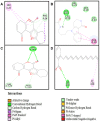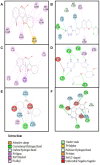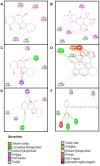Enhanced Accumulation of Cisplatin in Ovarian Cancer Cells from Combination with Wedelolactone and Resulting Inhibition of Multiple Epigenetic Drivers
- PMID: 34079223
- PMCID: PMC8164677
- DOI: 10.2147/DDDT.S288707
Enhanced Accumulation of Cisplatin in Ovarian Cancer Cells from Combination with Wedelolactone and Resulting Inhibition of Multiple Epigenetic Drivers
Abstract
Purpose: Cisplatin resistance is a major concern in ovarian cancer treatment. The aim of this study was to investigate if wedelolactone could perform better in resistant ovarian cancer cells when used in combination with cisplatin.
Methods: Growth inhibitory potential of wedelolactone and cisplatin was investigated through MTT reduction assay in ovarian cancer cell lines including A2780 (sensitive), A2780cisR (cisplatin resistant) and A2780ZD0473R. Resistance factor (RF) of drugs was determined in these three cell lines. Combination index (CI) was calculated as a measure of combined drug action. Effect of this combination on changes in the cellular accumulation of platinum levels and platinum-DNA binding was also determined in vitro using AutoDock Vina while the effect of wedelolactone on inhibition of possible key culprits of resistance including Chk1, CD73, AT tip60, Nrf2, Brd1, PCAF, IGF1, mTOR1 and HIF2α was investigated in silico.
Results: Cisplatin and wedelolactone showed a dose-dependent growth inhibitory effect. RF value of wedelolactone was 1.1 in the case of A2780cisR showing its potential to bring more cell death in cisplatin-resistant cells. CI values were found to vary showing antagonistic to additive outcomes. Additive effect was observed for all sequences of administration (0/0, 0/4 and 4/0 h) in A2780cisR. Enhanced cellular accumulation of cisplatin was observed in parent and resistant cells on combination. Docking results revealed that among the selected oncotargets, Chk1, CD73, Nrf2, PCAF and AT tip60 were more vulnerable to wedelolactone than their respective standard inhibitors.
Conclusion: These findings have shown that additive outcome of drug combination in A2780cisR and raised levels of platinum accumulation followed a clear pattern. This observation indicates that the presence of wedelolactone might have contributed to sensitize A2780cisR. However, in silico results point to the possible effects of this compound on epigenetic factors involving tumor microenvironment, epithelial mesenchymal transition, and immune-checkpoint kinases.
Keywords: A2780; chemotherapy resistance; coumestan; growth inhibition.
© 2021 Sarwar et al.
Conflict of interest statement
The authors report no conflicts of interest in this work.
Figures











Similar articles
-
Synthesis of a monofunctional platinum compound and its activity alone and in combination with phytochemicals in ovarian tumor models.Anticancer Res. 2014 Dec;34(12):7077-90. Anticancer Res. 2014. PMID: 25503135
-
Synthesis of trans-bis-(2-hydroxypyridine)dichloroplatinum(II) and its activity in human ovarian tumour models.Anticancer Res. 2012 Jan;32(1):135-40. Anticancer Res. 2012. PMID: 22213298
-
Studies on combinations of platinum with paclitaxel and colchicine in ovarian cancer cell lines.Anticancer Res. 2010 Oct;30(10):4025-37. Anticancer Res. 2010. PMID: 21036717
-
Breaking the barrier: Epigenetic strategies to combat platinum resistance in colorectal cancer.Drug Resist Updat. 2024 Nov;77:101152. doi: 10.1016/j.drup.2024.101152. Epub 2024 Sep 28. Drug Resist Updat. 2024. PMID: 39369466 Review.
-
Cisplatin resistance: a cellular self-defense mechanism resulting from multiple epigenetic and genetic changes.Pharmacol Rev. 2012 Jul;64(3):706-21. doi: 10.1124/pr.111.005637. Epub 2012 Jun 1. Pharmacol Rev. 2012. PMID: 22659329 Free PMC article. Review.
Cited by
-
Molecular mechanisms of cisplatin resistance in ovarian cancer.Genes Dis. 2023 Aug 2;11(6):101063. doi: 10.1016/j.gendis.2023.06.032. eCollection 2024 Nov. Genes Dis. 2023. PMID: 39224110 Free PMC article. Review.
-
Insights Into the Role of Epigenetic Factors Determining the Estrogen Response in Estrogen-Positive Ovarian Cancer and Prospects of Combining Epi-Drugs With Endocrine Therapy.Front Genet. 2022 Jul 8;13:812077. doi: 10.3389/fgene.2022.812077. eCollection 2022. Front Genet. 2022. PMID: 35873467 Free PMC article. Review.
-
Wedelolactone facilitates the early development of parthenogenetically activated porcine embryos by reducing oxidative stress and inhibiting autophagy.PeerJ. 2022 Jul 25;10:e13766. doi: 10.7717/peerj.13766. eCollection 2022. PeerJ. 2022. PMID: 35910774 Free PMC article.
-
Review on effects and mechanisms of plant-derived natural products against breast cancer bone metastasis.Heliyon. 2024 Sep 13;10(18):e37894. doi: 10.1016/j.heliyon.2024.e37894. eCollection 2024 Sep 30. Heliyon. 2024. PMID: 39318810 Free PMC article. Review.
-
Regulating mitochondrial oxidative phosphorylation and MAPK signaling: wedelolactone as a novel therapeutic for radiation-induced thrombocytopenia.Front Pharmacol. 2025 Apr 30;16:1508215. doi: 10.3389/fphar.2025.1508215. eCollection 2025. Front Pharmacol. 2025. PMID: 40371333 Free PMC article.
References
-
- Surveillance, Epidemiology & End Results Program at the National Institute of Health. SEER stat fact sheets: ovary cancer. Available from: http://seer.cancer.gov/statfacts/html/ovary.html. Accessed April28, 2021.
-
- Prior JC. Ovarian aging and the perimenopausal transition: the paradox of endogenous ovarian hyper stimulation. Endocrinology. 2005;26:297–300. - PubMed
-
- Surveillance, Epidemiology and End Results Program at the National Institute of Health. SEER stat fact sheets: ovary cancer. Available from: http://seer.cancer.gov/statfacts/html/ovary.html. Accessed April28, 2021.
-
- Tummala MK, McGuire WP. Recurrent ovarian cancer. Clin Adv Hematol Oncol. 2005;9:723–736. - PubMed
MeSH terms
Substances
LinkOut - more resources
Full Text Sources
Medical
Research Materials
Miscellaneous

